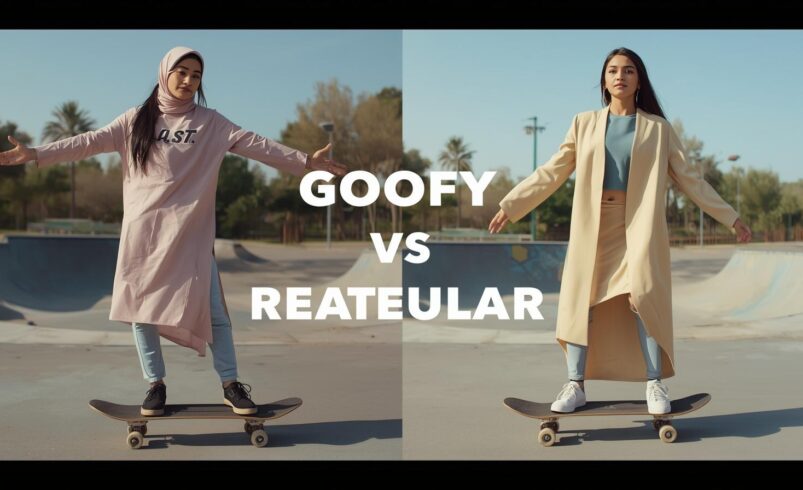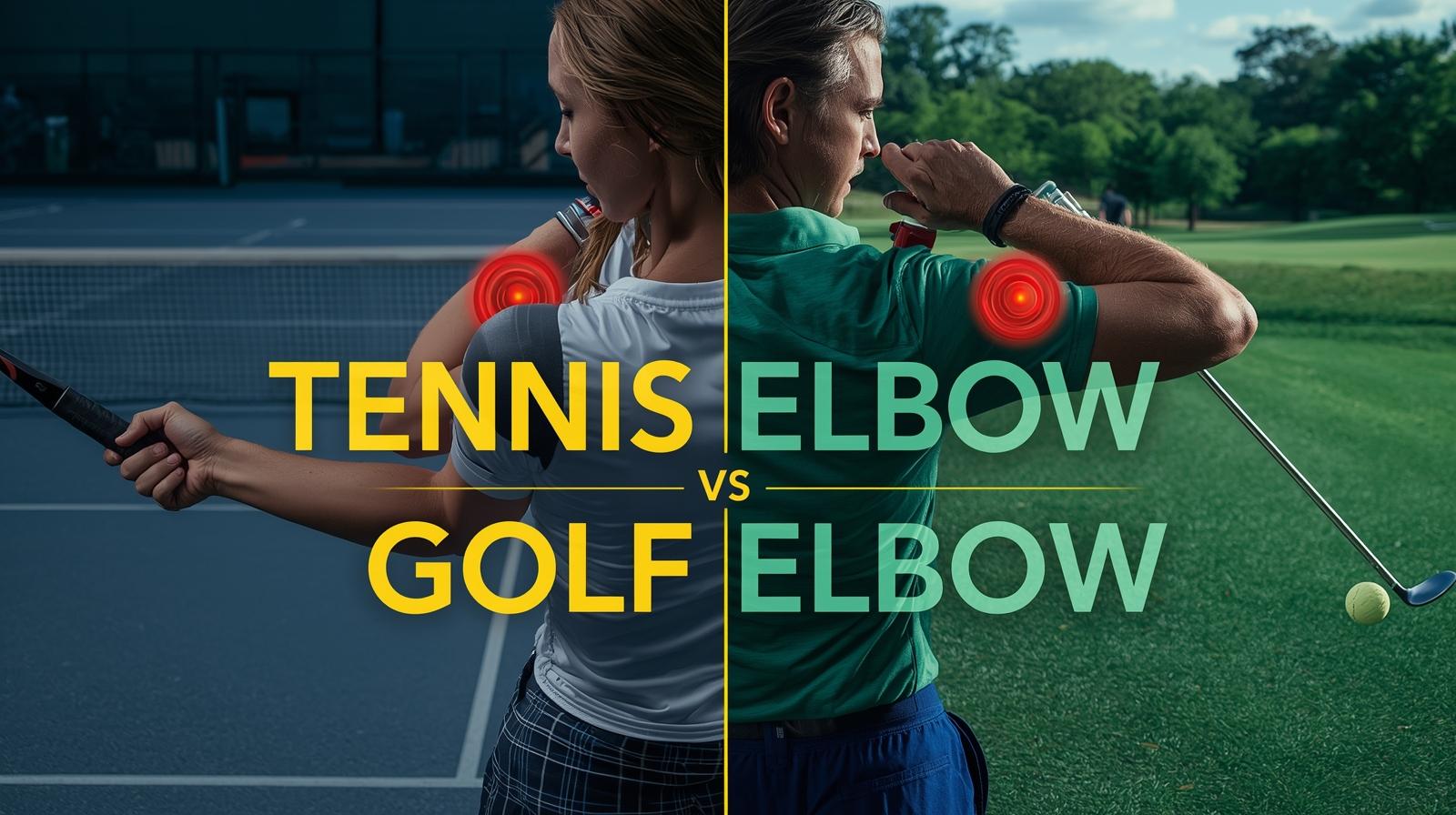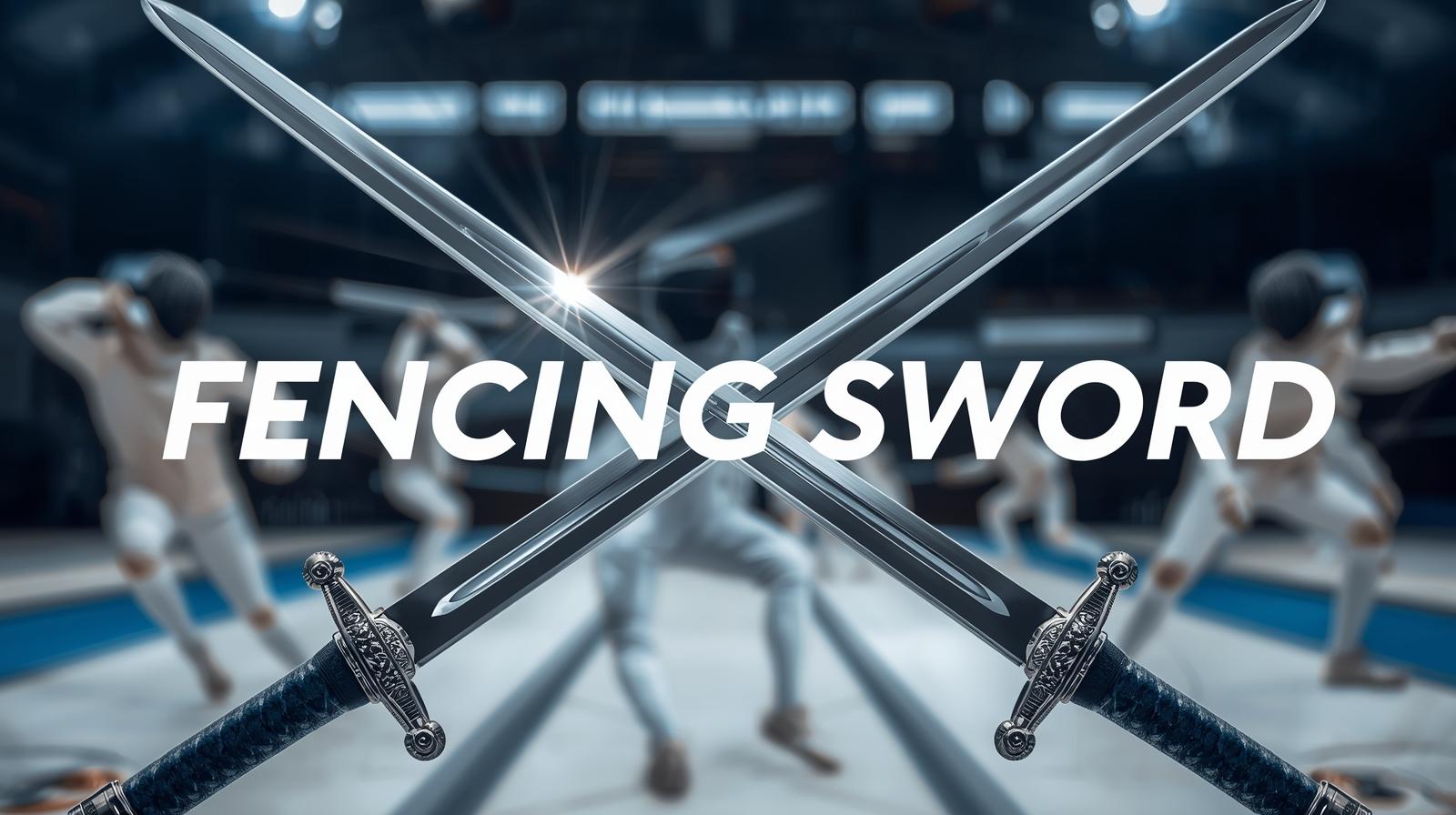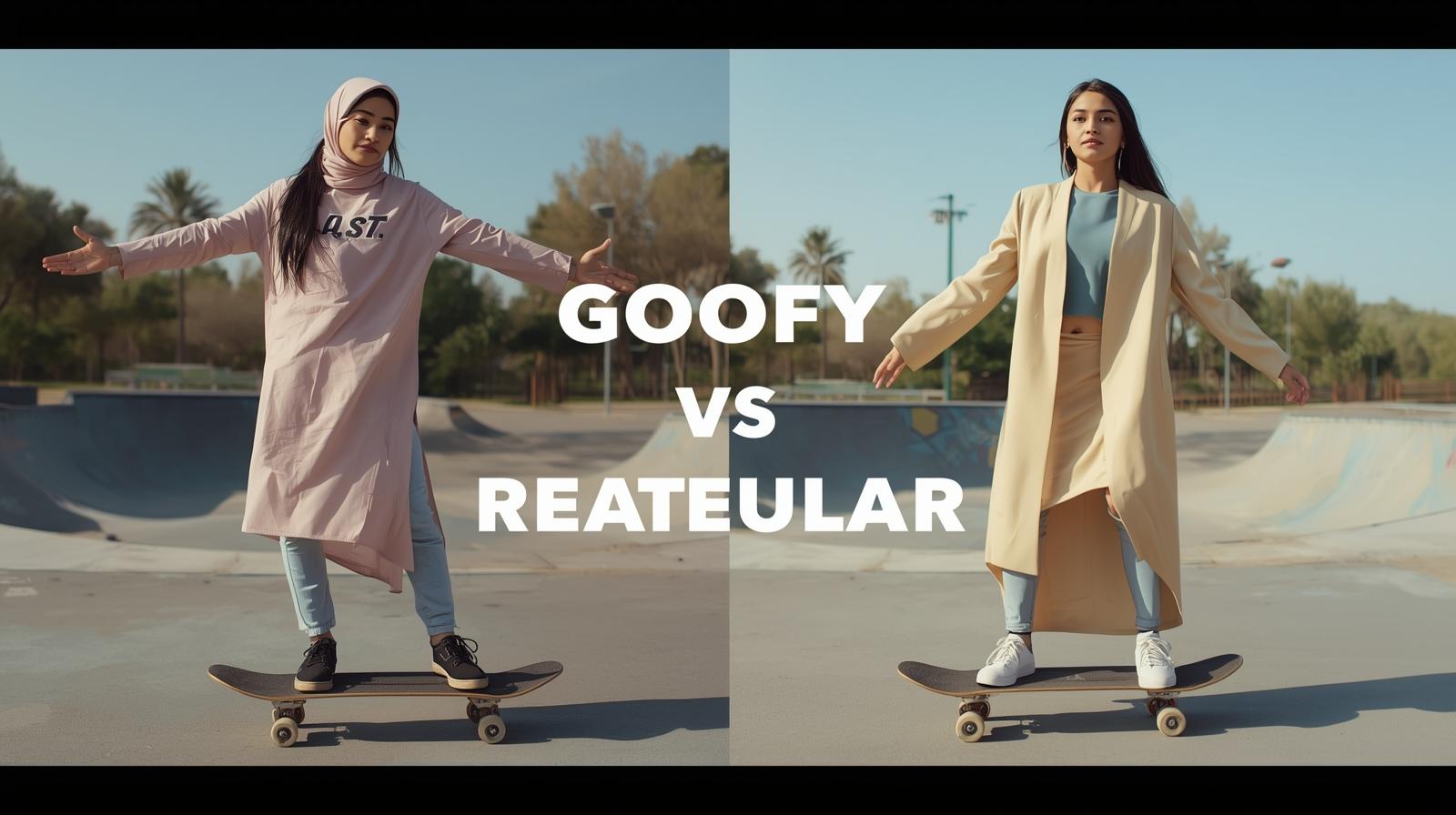Stepping onto a skateboard for the first time brings an unexpected question: which foot goes forward? This simple decision goofy vs regular skateboard stance shapes everything about how you’ll ride. I remember my first time on a board, awkwardly shifting my weight back and forth, wondering why something so natural to others felt like solving a puzzle.
The truth is, your stance isn’t just about comfort. It’s your skateboarding identity. Whether you ride with your left foot forward (regular) or right foot leading (goofy), understanding this fundamental choice unlocks your potential on four wheels.
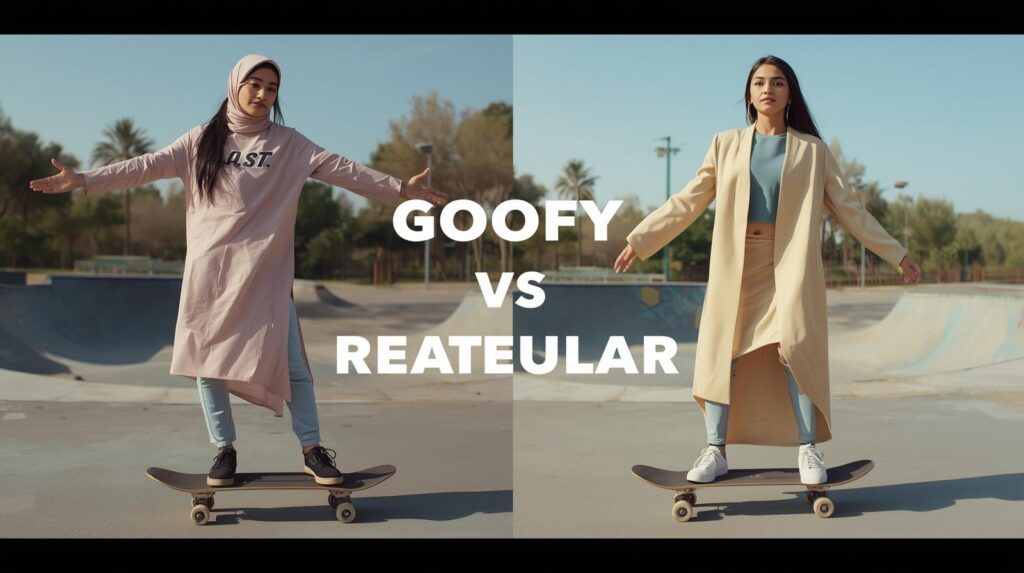
Understanding Goofy vs Regular Skateboard Stances
The goofy vs regular skateboard debate centers on foot placement. Regular stance means your left foot stays forward on the board while your right foot provides the pushing power from behind. Think of it as the traditional approach hence the name “regular.”
Goofy stance flips this completely. Your right foot leads at the board’s nose, while your left foot anchors the tail and handles pushing duties. Despite the quirky name, there’s nothing awkward about it. The term reportedly originated from a 1937 Disney short film where the character Goofy surfed with his right foot forward, creating a lasting legacy in board sports.
Neither stance offers inherent advantages. Your body naturally gravitates toward one position, making the goofy vs regular skateboard choice deeply personal rather than technical.
The Statistics Behind Goofy vs Regular Skateboard Riders
Recent data reveals fascinating patterns in the goofy vs regular skateboard distribution. According to analysis of the Skatepark of Tampa database containing over 4,000 skateboarder profiles, approximately 44% ride goofy while 56% prefer regular stance. This challenges the assumption that goofy riders are rare.
However, different studies show varying percentages. A 2024 analysis of 610 World Skate-ranked professional skateboarders found 53% ride goofy and 47% regular nearly an even split at the professional level. Traditional estimates suggested only 25% of skaters ride goofy, but current data proves goofy stance is far more common than previously thought.
| Stance Type | SPoT Database | World Skate Pros | Traditional Estimate |
|---|---|---|---|
| Regular | 56% | 47% | 75% |
| Goofy | 44% | 53% | 25% |
The goofy vs regular skateboard split varies by region too. Countries like the UK, Peru, Colombia, and Argentina lean heavily toward goofy riders (50-60%), while Japan and Australia show strong preferences for regular stance (30-40% goofy).
Interestingly, the 2020 Tokyo Olympics Men’s Street Skateboarding finals featured exclusively goofy-footed skaters, despite the sport’s relatively balanced stance distribution overall.
Famous Skateboarders: Goofy vs Regular Skateboard Legends
The goofy vs regular skateboard divide includes legendary names on both sides. Tony Hawk, arguably the most iconic skateboarder in history, rides goofy. The vert skateboarding pioneer has confirmed multiple times that he skates with his right foot forward, stating in his MasterClass, “I skate with my right foot, which means I’m goofy-footed.”
Rodney Mullen, the godfather of street skateboarding who invented countless tricks including the kickflip and heelflip, rides regular. His technical mastery proves that stance doesn’t determine skill ceiling.
Other notable goofy riders include:
- Felipe Gustavo (Brazilian Olympic competitor)
- Chris Russell (multiple contest winner)
- Leo Baker (first transgender pro in major competitions)
Regular stance champions include:
- Bob Burnquist (first Fakie 900 lander)
- Tyshawn Jones (youngest two-time Thrasher SOTY)
- Rodney Mullen (freestyle legend)
The goofy vs regular skateboard preference of professionals demonstrates that both stances produce world-class talent. Your stance choice won’t limit your potential dedication and practice matter far more.
How to Determine Your Goofy vs Regular Skateboard Stance
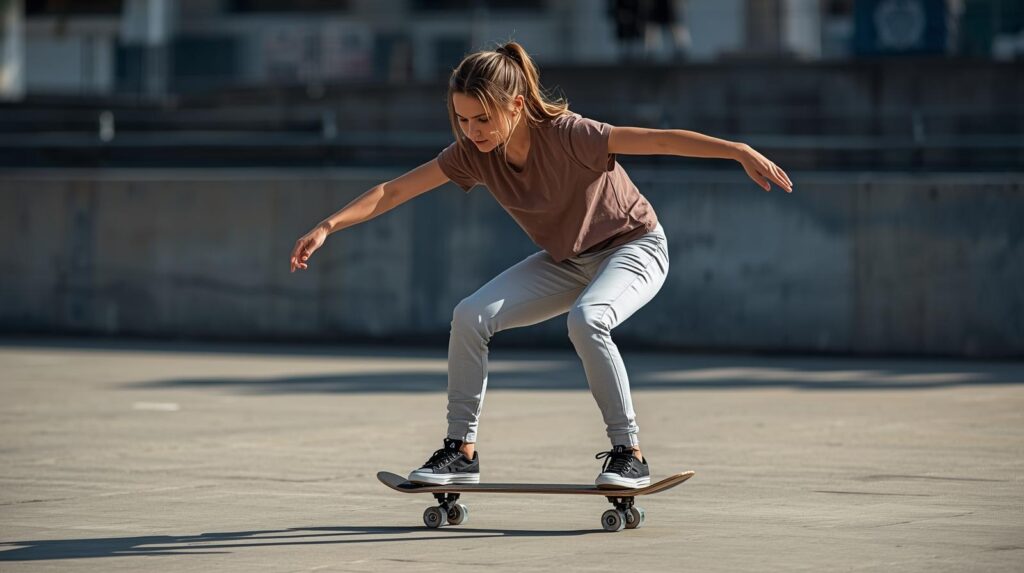
Finding your natural goofy vs regular skateboard preference doesn’t require guesswork. Several proven methods help identify your ideal stance:
The Push Test
Stand behind someone and have them gently push you forward. The foot you instinctively step forward with typically becomes your lead foot on the board. If your left foot moves first, you’re likely regular. Right foot forward suggests goofy.
The Stair Method
Walk up a staircase and notice which foot naturally steps up first. This dominant climbing foot often correlates with your skateboarding stance. Right-foot-first climbers typically ride regular, while left-foot-first climbers often ride goofy.
The Slide Test
On a smooth surface wearing socks, get a running start and slide like you’re hitting home plate in baseball. The foot that leads your slide usually becomes your front foot when determining goofy vs regular skateboard stance.
The Soccer Ball Method
Kick a soccer ball and observe which foot you use. Your kicking foot typically becomes your back foot on a skateboard. If you kick with your right foot, you’ll likely ride regular. Left-foot kickers often prefer goofy.
The Direct Approach
Simply step on a skateboard (on carpet or grass for safety) and roll forward gently. Your body instinctively knows its preferred goofy vs regular skateboard position. Trust your gut feeling the stance that feels natural is usually correct.
The Science Behind Goofy vs Regular Skateboard Preferences
The goofy vs regular skateboard split doesn’t correlate neatly with handedness. While 85-90% of people are right-handed, the skateboarding stance distribution sits closer to 50-60% regular and 40-50% goofy. This disconnect suggests foot dominance operates differently than hand dominance.
Research from Psychology Today indicates that 40% of left-handed people are right-footed, while only 3% of right-handed people are left-footed. However, these “action foot” patterns don’t directly predict skateboarding stance.
Your “stability foot” and “action foot” play different roles. The action foot typically provides power and precision (like kicking a ball), while the stability foot offers balance and support. In skateboarding, many riders use their stability foot as the lead foot, opposite to what you’d expect based on action foot dominance.
The goofy vs regular skateboard choice also appears influenced by:
- Early learning experiences and which stance feels comfortable initially
- Regional skateboarding culture and predominant stance among local skaters
- Individual balance preferences and spatial orientation
- Physical biomechanics and natural weight distribution
Switching It Up: Riding Switch and Fakie
Mastering the goofy vs regular skateboard fundamentals opens doors to advanced techniques. Switch stance means riding opposite your natural position regular riders skating goofy, and goofy riders skating regular. This dramatically expands your trick vocabulary.
Legendary skaters like Paul Rodriguez excel at switch skating, performing tricks equally well in both stances. This “bi-stance” ability takes years to develop but provides immense versatility.
Fakie stance means riding backwards in your natural stance. If you ride up a ramp and come back down without turning around, you’re riding fakie. This differs from switch fakie maintains your foot position but reverses your direction.
Understanding these variations of goofy vs regular skateboard riding:
- Regular stance: Left foot forward, right foot back
- Goofy stance: Right foot forward, left foot back
- Switch regular: Right foot forward (opposite of natural regular)
- Switch goofy: Left foot forward (opposite of natural goofy)
- Fakie: Riding backwards in your natural stance
Practicing switch and fakie improves overall board control, balance, and adaptability. Many professional contest runs incorporate switch tricks to demonstrate complete mastery beyond just goofy vs regular skateboard basics.
Common Myths About Goofy vs Regular Skateboard Stances
Several misconceptions surround the goofy vs regular skateboard debate:
Myth 1: Regular is better because it’s more common Truth: Neither stance offers performance advantages. The name “regular” simply indicates historical prevalence, not superiority.
Myth 2: Goofy riders are always left-handed Truth: Handedness and skateboarding stance show weak correlation. Plenty of right-handed skaters ride goofy, and left-handed skaters frequently ride regular.
Myth 3: You must ride the same stance across all board sports Truth: While most people maintain consistent stance across skateboarding, snowboarding, and surfing, some riders naturally prefer different stances for different sports.
Myth 4: Changing your stance later is impossible Truth: While initially challenging, dedicated practice allows skaters to become proficient in both stances. Your body adapts with consistent effort.
Myth 5: Professional skaters all ride regular Truth: Current data shows professional skateboarding splits nearly 50-50 between goofy and regular, with some competitions and regions favoring goofy stance.
The goofy vs regular skateboard choice remains personal. Trust your instincts and what feels natural rather than following perceived norms.
Practical Tips for New Skaters Choosing Between Goofy vs Regular
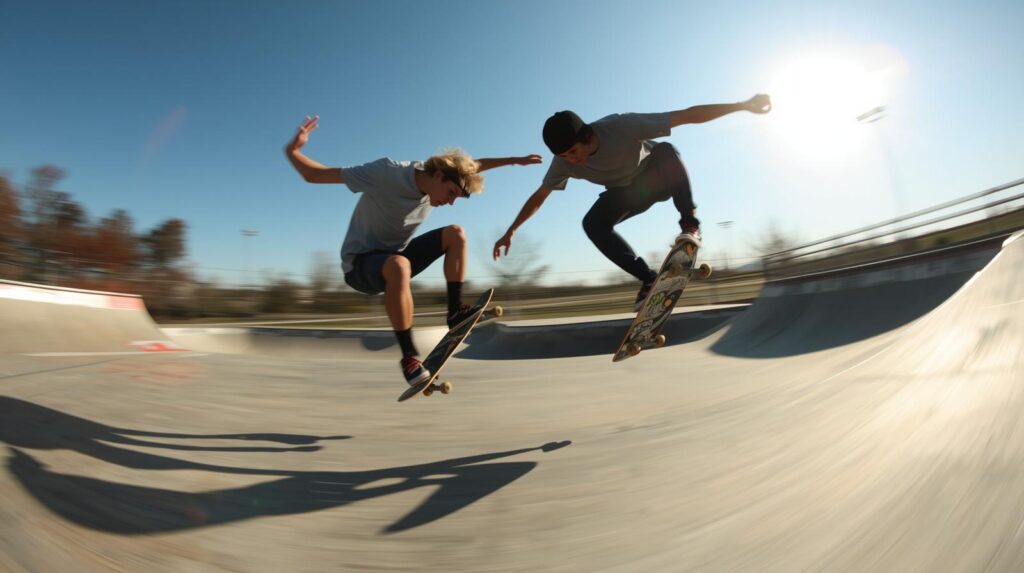
When starting your skateboarding journey, the goofy vs regular skateboard decision matters less than consistent practice. Here’s my advice based on years of skating and teaching beginners:
Start Simple: Don’t overthink the goofy vs regular skateboard debate. Try both positions for five minutes each on flat ground. One will feel distinctly more comfortable.
Commit Early: Once you identify your natural stance, commit to it for at least several weeks. Constantly switching between goofy vs regular skateboard positions delays progress and confuses muscle memory.
Film Yourself: Record short clips of your skating in both stances. Visual feedback often reveals which position looks and flows more naturally, even if you can’t feel the difference initially.
Seek Community Input: Local skaters at your Alldandy skate spot can offer valuable observations. Sometimes an experienced eye notices things you miss about your goofy vs regular skateboard stance preference.
Prioritize Comfort: Pain, awkwardness, or excessive instability in one stance signals it’s probably not your natural choice. The right goofy vs regular skateboard stance feels intuitive, not forced.
Accept Imperfection: Even in your natural stance, skateboarding feels wobbly initially. Don’t abandon your stance choice just because early attempts feel clumsy that’s completely normal.
The Future of Goofy vs Regular Skateboard Culture
The skateboarding world continues evolving its perspective on the goofy vs regular skateboard distinction. Modern skateparks design features accessible from both stances, acknowledging that nearly half of all riders are goofy-footed.
Competition judging now recognizes switch tricks equally with natural stance maneuvers, reducing any historical bias toward regular riders. The goofy vs regular skateboard conversation increasingly focuses on inclusivity rather than conformity.
Technology also influences stance dynamics. Video game franchises like Tony Hawk’s Pro Skater let players select goofy vs regular skateboard preferences, normalizing both options for millions of virtual skaters worldwide.
Social media platforms showcase incredible skaters of all stances, demolishing outdated stereotypes. Young skaters now see equal representation of goofy and regular riders at the highest levels, making stance choice feel less consequential to their development.
The message is clear: whether you ride goofy vs regular skateboard stance, the skateboarding community welcomes you. Focus on progression, creativity, and fun rather than conforming to any particular standard.
Conclusion: Your Stance, Your Journey
The goofy vs regular skateboard debate ultimately boils down to personal preference rooted in biomechanics and comfort. With professional skaters split nearly evenly between both stances and legends like Tony Hawk proving that goofy riders can achieve anything, your choice doesn’t determine your ceiling.
Statistics show that 44-53% of skaters worldwide ride goofy, making it far more common than traditionally believed. Whether you’re part of the regular majority or the goofy near-majority, your stance simply represents your unique approach to skating.
Finding your natural goofy vs regular skateboard position through simple tests the push test, stair method, or direct trial sets the foundation for everything that follows. Once identified, commit to that stance, practice consistently, and eventually explore switch riding to expand your repertoire.
The skateboarding journey transcends foot placement. Style, creativity, progression, and community matter infinitely more than whether your right or left foot leads. So step on that board, trust your instincts about goofy vs regular skateboard stance, and start rolling.
Remember: the best stance is the one that helps you express yourself and progress confidently. Which foot naturally leads when you imagine carving down your local street?
FAQs About Goofy vs Regular Skateboard Stances
Q: Does goofy vs regular skateboard stance affect which tricks I can learn?
A: No, both stances can perform identical tricks. Certain tricks might feel slightly more intuitive in one stance initially, but dedicated practice overcomes any perceived differences. Professional skaters in both stances demonstrate the full spectrum of technical possibilities.
Q: Can I change my goofy vs regular skateboard preference after years of skating?
A: Yes, though it requires patience and practice. Many experienced skaters develop proficiency in both stances through dedicated switch riding practice. Your body can adapt to a new stance, but expect a learning curve similar to starting skateboarding fresh. The investment often pays dividends in versatility and trick options.
Q: Why do goofy vs regular skateboard percentages vary between different studies?
A: Sample sizes, geographic regions, skill levels, and data collection methods all influence stance statistics. The Skatepark of Tampa database includes primarily competitive skaters, while World Skate data focuses on internationally ranked athletes. Regional skateboarding cultures also demonstrate distinct stance preferences, from Japan’s regular-leaning community to South America’s goofy-dominant scenes.
Q: Should I match my goofy vs regular skateboard stance with my snowboarding or surfing stance?
A: Most people naturally ride the same stance across all board sports, but some individuals find different stances comfortable for different activities. Try your skateboarding stance first when approaching new board sports, but remain open to variation if it feels more natural.
Q: Does mongo pushing relate to goofy vs regular skateboard stance?
A: Mongo pushing (pushing with your front foot instead of back foot) can occur with either goofy or regular stance. While less common and often considered awkward by skateboard traditionalists, some professional skaters successfully use mongo pushing. However, most coaches recommend standard pushing technique regardless of your goofy vs regular skateboard preference.

